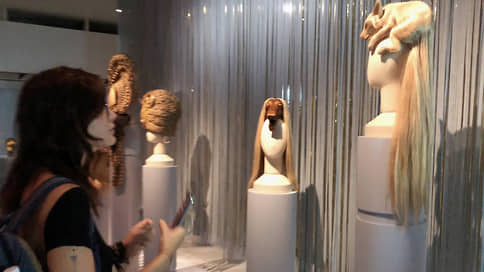Review of the Hair and Wool exhibition at the Musée des Arts Décoratifs in Paris
[ad_1]

The Musée des Arts decoratifs in Paris hosts the Hair and Wool exhibition, which tells about cutting, curling and shaving from the high positions of history, philosophy, social movements and decorative arts. According to the correspondent of “Kommersant” in France Alexey Tarkhanov.
“Not all shear that grows” – an aphorism of Kozma Prutkov. A new exhibition at the Musée des Arts Décoratifs in Paris is an excellent illustration of it. Its name can be translated simply as “Hair and wool”, but in French it sounds more complicated: “Des cheveux et des poils” – this is, more precisely, the hair on the head and the hair on the body. Some are proud, others are ashamed.
The exhibition is divided into two floors: below – history, above – modernity. In historical halls, everything begins with sculptures – a “wild man”, extremely furry, and a beautiful lady with smooth skin and carefully styled hair.
The path of civilization is outlined – we are led to progress by a hairdresser who is entrusted not only to curb our savagery, but also to turn it into a work of art.
Caring for what grows on you was considered one of the signs of a person’s emancipation, his difference from a furry beast. Having conquered hair and wool, the man turned into a smooth likeness of an ancient statue, never showing its shameful thickets and showing a hairstyle ordered by the sculptor’s chisel. Moreover, it was not always possible to brag about it. In the 15th century, women were required to cover their heads so as not to embarrass those around them with the devilish beauty of their hair.
But already in the 18th century, court hairdressers, especially the glorious Monsieur Leonard, who was more difficult to get to than the current fashion master, created real sculptures on the heads of aristocrats. Volumetric figures on a wire basis from their own and other people’s hair sometimes reached a meter in height and weighed up to five kilograms. The main problem for the clients was not the cost, which reached the current fifty thousand euros, but the need to reconcile the scale of the idea with the implementation time, which required from several hours to a whole day. Topics are relevant. In the morning in the newspaper, in the evening on the head. In honor of the glorious victory of the frigate Belle Bullet over the British enemy, Marie Antoinette came out in her hair with the image of the Beautiful Hen with all three masts sticking out over her head.
The story is also about the beard – the very one with which Peter I fought, but never won, – which, out of facial shame, became a symbol of power and masculinity, an adornment of the last Russian tsars. The beard could be a banner of rebellion and a badge of honor, like the beards of the “grouches” of Napoleon’s “old guard” or the current pioneer veterans of the Foreign Legion. A whole set of tools was attached to the beard and mustache: razors, wax, shaving brushes, combs, supports for eating and drinking – a whole showcase is filled with them. One can observe a long way from a relative of the cutlass, Sweeney Todd’s straight razor, with which it was possible to shave not only beards, but also wallets, to the shiny steel rectangle of the “jacket”, which Mandelstam compared with the “calling card of a Martian.” Who doesn’t have a beard now? Certainly not a coachman on a dung barrel, but a cheerful hipster on a scooter.
The line of wigs of Elisabeth of Austria, against the background of her ceremonial images, is adjacent to the magnificent sideburns of her husband Franz Joseph. The only portrait in which Sissi appeared with free hair was intended only for the family art gallery, something like a home video of the century before last. A special story is told about body hair, unshaven pubes and armpits, and it is illustrated with rather free photographs of male and female bodies. It is the hair that frames the “origin of the world” on the famous Courbet canvas, exhibited here with honor on a separate wall. The hard labor of a woman to remove body hair and her current right to keep it speaks in fables about the suffering of bald and bald men, whom the fashion for a shaved “like a billiard ball” skull freed from the former humiliating pettiness. On the walls there are posters of touring circuses with people overgrown to the state of baboons, advertisements of “women with a beard”, considered the characters of a panopticon, and now they have entered the stage.
The first floor is a real encyclopedia of wool and hair, and it is on it that most of the time is spent. By the second, visitors get tired, meanwhile, it is there that the most interesting is located. It all starts with the ingenious machines of the 20th century for drying, washing and coloring hair. This is the moment when the process of a woman’s haircut from the barber’s hole entered the Ford assembly line, revealing rows of women under cosmic caps in glass showcases, directly communicating with the gods of beauty. The current hairdressers, French and world champions like Olivier Chawalder or Jean-Baptiste Santens, have not lost the ability to sculpt women’s hair sculptures, depicting fantastic animals or geometric figures. Here are the furry outfits of Martin Margiela, whose dress is born from a hairstyle. So the exhibition ends loudly, festively, with all its might.
[ad_2]
Source link






